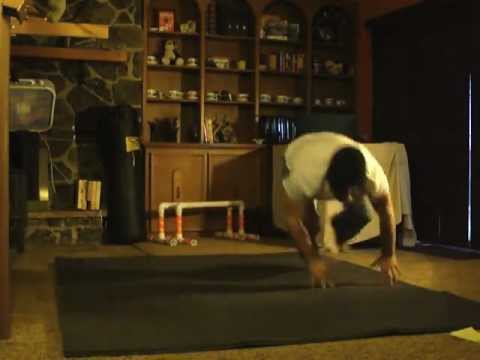The moment that pushups become second nature to you and your body is the moment that you need to incorporate new pushup variations. Let’s take a stroll along the path of reasoning and explore how variation allows for the process of progression to break through its barriers.
When The Going Becomes Easy… Variation Is The Key
At one point in life, none of us were able to even walk. As we learned how to walk, and then became more proficient at it, we arrived at a stage where walking developed into a movement that was second nature to us. We were then able to increase the complexity of walking by changing the timing, speed, and movement of the legs and the rest of the body. These changes in time, speed, and movement resulted from the addition of a new stimulus to the body. We stimulated certain muscles and created more efficient nerve pathways from the brain and/or central nervous system down to the neuromuscular junction—the area where the nervous system and the contractible muscles meet. If we never stimulated the body in such a way, all we would proficiently be able to do is walk.
At a certain point, you cannot become much better at walking than you already are. This would be great if walking was all that we needed to do or if it was the only thing that we desired to do. However, especially in the fitness world, we strive to want to do more. We have this strong and passionate desire to want to progress physically, mentally and emotionally. It doesn’t matter if we desire to lift more weight, increase our performance level, become fit, increase the size of our muscles, feel better about ourselves, etc., we are always trying to progress ourselves.
Here’s my point:
If all you ever do is walk, you will never be proficient at anything that is higher in complexity such as running. We need to introduce a new stimulus in order to allow for progression. Unfortunately, we are creatures of habit especially when we are unaware of any other way. This leads us to doing the same exercise over and over and over again. At first, you see that progression is coming fast and easy, but eventually you begin to wonder what happened to those progressions and why you are no longer reaching your goals no matter how much of that habit you do or how hard you work. Remember: It is not a matter of doing more or working harder that holds your answer; rather it is a matter of introducing a new stimulus that will take you back to your progressive ways.
Relation to Pushups
There is a point where a certain exercise becomes second nature to us, just as walking does. In the case of a pushup, you might naturally start out doing a few pushups, but if you keep doing them, you will go through some rapid progressions where the number of pushups that you can do at one time increases a significant amount. Eventually a point is reached where the pushup becomes easy and the progressions will not be as rapid as they used to be. It is at this point that you need to incorporate a variety of similar exercises to assist in this progression—this variety will provide a different stimulus than that of which the body is familiar with.
[youtube https://www.youtube.com/watch?v=4Sz1gg0MuMs&w=420&h=315]
The video depicted above shows a pushup variation that is very similar to a pushup, but can be used to stimulate the body in a different way than it is accustomed to. This new stimulation, as mentioned multiple times throughout this article will help increase the amount that your body adapts and progresses.
I recommend that you do not just stop at that one pushup variation shown in the video, but use your own creativity to generate more variations. In this case, it could be said that the more variation you add, the merrier you will be.
Greg Pearson is an exercise science major at Shippensburg University of Pennsylvania with minors in biology and coaching. He is also a lifelong athlete – involved in the sports of basketball, baseball, football, track & field and volleyball growing up. Competed at Shippensburg University in the shot put, discus, and hammer events as a Division II Track & Field athlete. You can contact Greg via e-mail: [email protected] or his linkedin profile.

